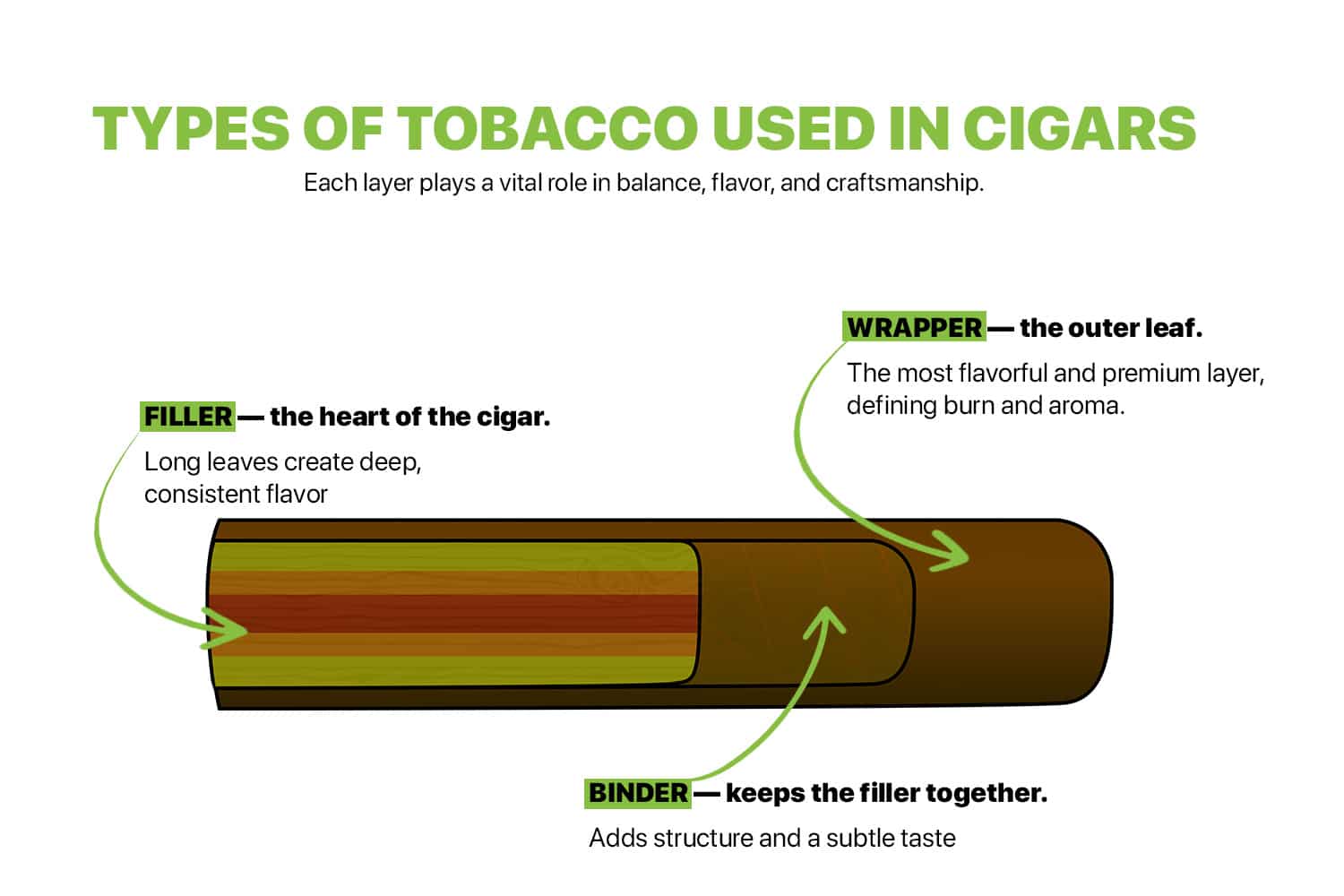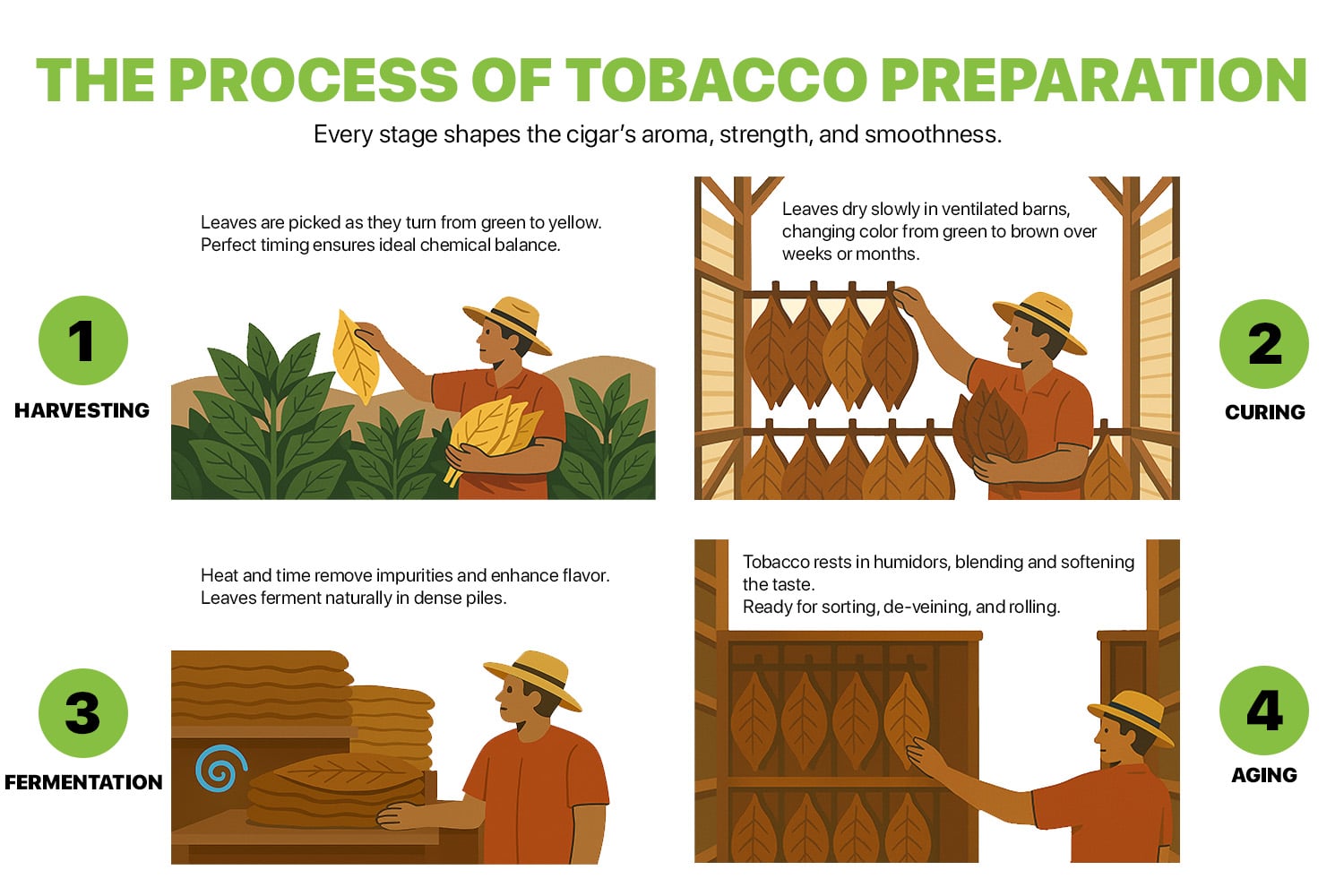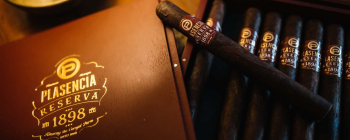
How Much Tobacco is in a Cigar?
Tobacco is the essential component of a cigar. In fact, premium options are made entirely out of the plant’s leaves. The filler, binder, and wrapper are all formed from aged and fermented tobacco leaves. This helps to create unique flavors and smoking experiences.
Among the thousands of natural chemicals within tobacco leaves is nicotine. This is the addictive substance that makes cigars so difficult to resist.
In this article, we’ll explain the importance of both tobacco and nicotine content to cigars. We’ll also assess how the content varies between different types of cigar.
Tobacco in a Cigar: Types, Nicotine, Process
A cigar is a culmination of multiple tobacco leaves. You’ve got the filler, which is the main bulk of the cigar, formed by tightly packed leaves. This is wrapped in a binder leaf, which holds the filler together. Then, there’s the outer layer of the cigar, known as the wrapper.
This is made up of a specially cultivated tobacco leaf. It’s usually the most expensive and high-quality leaf in the entire cigar.
Tobacco vs Nicotine
Tobacco contains numerous chemicals, none more well-known than nicotine. While nicotine isn’t harmful to the body once consumed, it is highly addictive. Addiction leads to frequent use and greater exposure to the other chemicals within cigars. These include tar and carbon monoxide.
Nicotine is naturally found in tobacco leaves at a high concentration. It serves as a deterrent against insects. It is found in other sources, such as tomatoes, tea, and peppers. However, the concentration is much lower, with tobacco being its primary source.
Types of tobacco used in cigars

There are three types of tobacco used in cigars. These are the filler, binder, and wrapper. Each serves a crucial purpose in creating a smokeable stick.
- Filler: The filler is the tobacco inside the cigar. In premium cigars, long-filler is used. This is whole tobacco leaves running through the length of the cigar. Lower-quality cigars use short-filler, which is usually the chopped remnants of long-filler tobacco. In some cases, mixed-filler is used, which combines the two.
- Binder: The binder is an inner tobacco leaf layer that holds the filler together. This keeps the filler structured, ensuring the cigar doesn’t fall apart. The binder often adds a little extra flavor to the cigar, too.
- Wrapper: The wrapper is the outer tobacco leaf that holds everything together. It’s usually the most flavorsome, expensive leaf. It contributes significantly to the cigar’s overall quality. It’s also responsible for the cigar’s burn quality and structural integrity.
The process of tobacco preparation

There are four main stages to tobacco preparation for cigars. These are:
- Harvesting: Tobacco leaves are harvested just as the color begins to change from green to yellow. This is the stage where the plants are withdrawing nutrients. Therefore, they contain the correct chemical changes for curing. Leaves are either harvested by the leaf (priming) or by the entire plant (stalk cutting).
- Curing: This stage involves drawing out the moisture from the tobacco leaves. They are hung in ventilated barns to slowly dry out. Their color changes from yellowish-green to yellow, and then to brown. This process can take months, depending on the desired flavor of the cigar.
- Fermentation: The fermentation process involves removing the tobacco of impurities, such as ammonia. It also helps to create complex, interesting flavor compounds. This is done by gathering leaves into dense piles. As a result, they will generate their own heat and ferment. This process takes months, with the leaves frequently re-piled for even heat distribution.
- Aging: The final step of the leaves’ journey is aging. The leaves are placed into an aging container or humidor, allowing the flavors to meld. This step also creates a smoother smoke once the leaves have been rolled into the cigar.
When the tobacco is ready, the leaves will be sorted by quality and color ready to be rolled. The filler leaves will be drier than the binder and wrapper leaves. Each leaf will be de-veined, removing the thick central stem from the leaf.
How Much Tobacco is in a Cigar?
Cigars can be filled with as little as one gram of tobacco for smaller sizes. Larger cigars may include over 20 grams of tobacco. For context, some large cigars contain more tobacco than an entire pack of cigarettes.
Let’s take a closer look at the tobacco content of a range of cigar sizes:
- Cigarillo: A standard cigarillo contains around 3g of tobacco.
- Panetela: Panetelas usually contain between 3.5-5g of tobacco.
- Petit Corona: A petit corona usually contains around 6-7g of tobacco.
- Corona: The standard corona cigar contains between 8-11g of tobacco.
- Robusto: Robustos contain between 11g and 17g of tobacco.
- Toro: Toro cigars can contain between 10-21g of tobacco.
- Churchill: Churchill cigars can contain up to 22g of tobacco in a single cigar.
Here’s a table for quick comparison:
| Cigar | Tobacco Content (g) |
| Cigarillo | 3 |
| Panetela | 3.5 - 5 |
| Petit Corona | 6 - 7 |
| Corona | 8 - 11 |
| Robusto | 11 - 17 |
| Toro | 10 - 21 |
| Churchill | 12 - 22 |
The tobacco content of each cigar type depends heavily on the manufacturer. While some forms of cigar have standardized sizes, tobacco content may still vary.
How Much Nicotine is in a Cigar?
How much nicotine in a cigar will vary depending on its size and the amount of tobacco filler inside. Nicotine is a natural chemical compound found in tobacco leaves. The plant is its primary source. Medium cigars can contain between 100-200 milligrams of nicotine.
Large cigars can contain up to 400mg of nicotine. Smaller cigars, such as cigarillos contain between five and 50mg. In contrast, a cigarette contains around 8mg of nicotine. This means that large cigars can contain more nicotine than a single pack of cigarettes.
Here are some factors that can affect the nicotine content of a cigar:
- Size: Large cigars contain more tobacco, which naturally increases the nicotine content.
- Fermentation: Tobacco fermentation often lowers nicotine content, with bacteria converting it into other compounds.
- Airflow: The airflow and ease of draw don’t directly affect the nicotine content. A tight draw can affect how much nicotine the smoker can draw from the cigar.
- Tobacco blend: Using a variety of leaves in a cigar affects its nicotine content. That’s because some leaf varieties contain more nicotine than others.
Bottom Line
A great cigar isn’t created during the rolling process. Instead, it starts much earlier on, from the moment the tobacco seed is sown. Expert aging, fermentation, and cultivation are vital for manufacturers.
At Swiss Cuban Cigars, we stock a wide range of cigars crafted to the highest standard. Our produce is sourced from the most revered manufacturers across Cuba and the rest of the world.
Browse our store today to find your ideal cigar.
FAQs
Do cigars have tobacco?
They do. Tobacco is a key component of all cigars.
Is a cigar 100% tobacco?
This depends on the type of cigar you’re smoking. Premium cigars are made entirely from tobacco, with a leaf wrapper, binder, and filler. Lower-quality cigars are more likely to contain additives and flavored materials.
How long does nicotine stay in your system?
The time that nicotine stays in your system depends on the type of test you take. For blood and saliva, it lasts between one to three days. For urine, the timeframe widens, lasting between two and 20 days. In hair samples, nicotine can remain for up to 90 days.
Nicotine will stay in your system longer after frequent intakes. If you’ve smoked for a long time, it will stay in your system longer than if you’re a casual, once-a-month smoker. Nicotine metabolism will also last longer in your system the older you get.
How much nicotine is in a cigar vs. cigarette?
Cigars contain more nicotine than cigarettes, due to the amount of tobacco inside. In fact, a single cigar can contain as much nicotine as an entire pack of cigarettes.
Most cigars will contain between 100-200 milligrams of nicotine. Some larger cigars contain up to 400 milligrams. In contrast, a cigarette will contain between eight to 12 milligrams of nicotine.
Are cigar wraps nicotine?
As cigar wrappers are made from tobacco leaves, they naturally contain nicotine. Cigar wrappers can contain 1.2 milligrams to 6 milligrams of nicotine alone. This means that cigar wrappers still contain the addictive substance without tobacco filler.
Oct 22, 2025
Last Modified: Oct 22, 2025

Table of Contents

